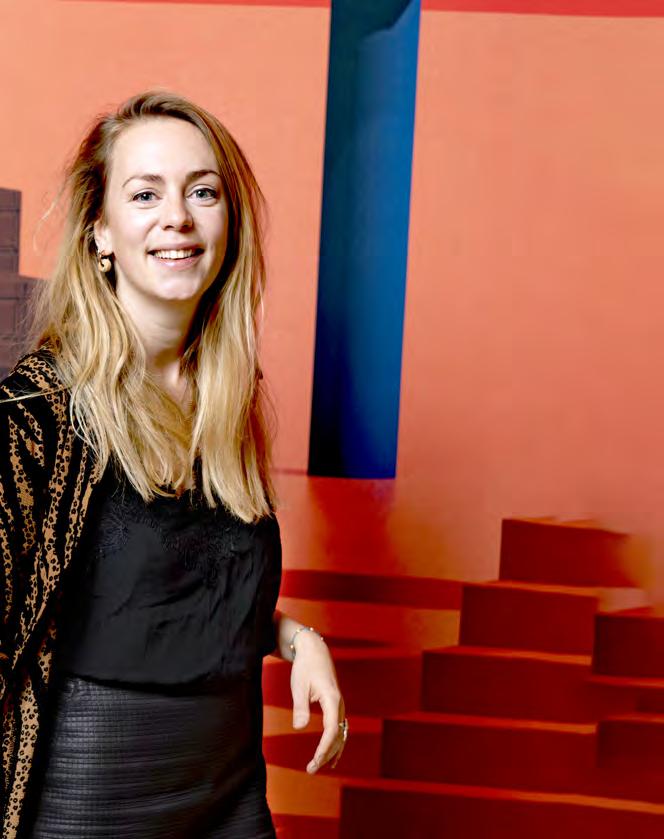
24 minute read
Same degree … different career
Same degree...
Judith Werkman (27)
Advertisement
Degree programme: Utrecht School of Governance Work: Project coordinator and ‘connector’ for the City Academy
‘O ur little city is growing like mad. This growth comes hand in hand with social issues from which students can learn a great deal. On behalf of the City Academy,
I collect problems and requests from the municipalities, provinces and housing corporations and translate them into projects for students in Utrecht, including UU students.
As an alumnus, it’s quite special to be collaborating with my University — sometimes
I find myself sitting across the table from the same professors who taught me! One great example of a UU project is the Warme Wijken (Warm neighbourhoods) initiative. At the behest of the city, Sociology students ask residents what they are doing to increase sustainability and whether they are interested in transitioning to a gas-free home in the future. For the students, it can be quite challenging to explain their complex research questions in plain language to the many different kinds of Utrecht residents they interview. Luckily, my university education taught me how the administrative landscape works. This helps me a lot.’
Daphne van Rhee (37)
Degree programme: Utrecht School of Governance Work: Policy adviser for the COVID-19 programme of the Netherlands Municipal Health Service (GGD)
‘L uckily, it’s not every day you have to deal with a pandemic. As the link between the GGD and the Ministry of Health, Welfare and Sport, I am literally at the centre of the action.
My colleagues and I are tasked with carrying out political wishes, such as widespread testing and mobile units for testing and vaccinating at the local level. Despite how busy it is,
I think my job would qualify as a dream job for many School of Governance students and alums. I’ve been seconded to the GGD by the city of Utrecht, where I’ve been working since 2015. Initially, that work was in connection with my thesis, which was about sports participation among girls with an immigrant background, and then in a position as a policy adviser focusing on issue such as promoting sports among people with a disability, community participation, loneliness and social entrepreneurship.’ ‘Looking back, complexity has always been a connective theme running through my career. Just put me somewhere there is a complicated to solve, and I’m happy. And of course
Utrecht is a wonderful city to work in. It’s always so friendly and cosy! I couldn’t have achieved all of this without UU.
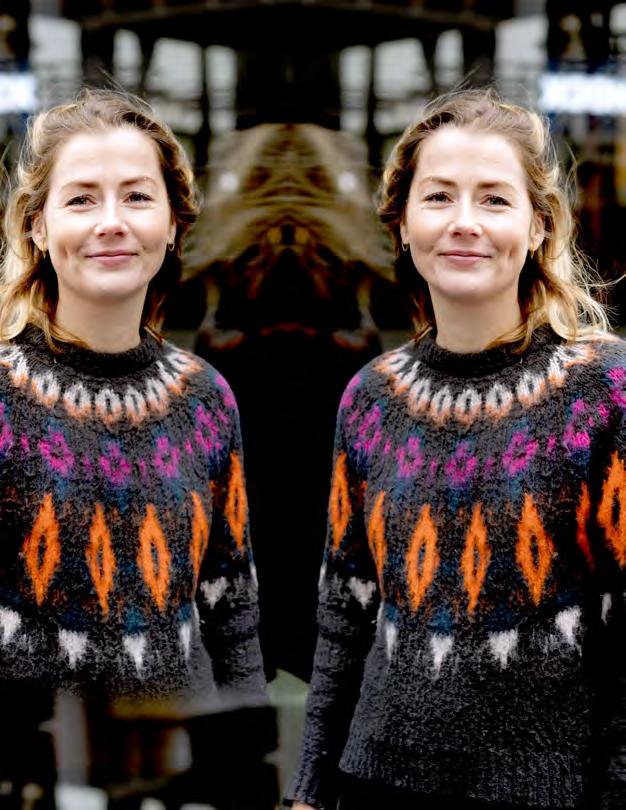
... different career
text Hanneke Olivier images Roderik Rotting
2006
Starts History degree programme at UU
2012
Publishes book Met de kennis van toen (With the Knowledge of Back Then)
2013
Publishes book De geschiedenis van de vooruitgang (The History of Progress) and begins working at De Correspondent
Between University and journalism
‘I realised relatively early in my career that rejection is not such a big deal.’ Rutger Bregman clearly isn’t one to let other people opinions (or the fear thereof) hold him back. By the time he was just 32, the Alumnus of the Year has already published six books. And millions of people saw just how unafrad of confrontation he is during his appearance at the World Economic Forum in Davos and in an interview on Fox News.
Technically, Bregman has actually published seven books: ‘As a student, I penned my magnum opus How to pass an exam: 30 tips.’ He laughs: ‘It’s a real collector’s item with two reviews on Bol.com. One review says “you should buy this right away” and the other says “worthless, no use to anyone”. The latter is absolutely correct. Still, that little book was important to me, because I suddenly understood: wait a minute, I can actually do this. All you need is one publisher that says yes. And if they say, “Dude, are you crazy?” I haven’t lost a thing. I sent it to thirteen publishers and the thirteenth one said yes.’
Embarrassing
As a secondary-school student, Rutger decided he was going to study History and become a teacher. But having arrived in Utrecht, he voraciously attended lectures on the most diverse
2014
Publishes book Gratis geld voor iedereen (Utopia for Realists)
2015
Publishes book Waarom vuilnismannen meer verdienen dan bankiers (Why Dustmen Deserve More than Bankers)
2019
Speaks at the World Economic Forum in Davos and confronts tucker Carlson during an interview with Fox News; both videos go viral. Publishes book De meeste mensen deugen (Humankind: A Hopeful History)
2020
Publishes book Het water komt (The Water is Coming)
range of topics and developed an overwhelming urge to write. ‘I used to write overly lengthy, rather mediocre articles for the magazine published by my student society, S.S.R.N.U. It’s embarrassing to read things I wrote back then. But that period did help me gain writing — and other — experience and gave me a chance to explore what I truly thought and wanted. It was an important moment, for instance, when I realised that I wasn’t cut out for a career in academia after all. At 22, I no longer wanted to be a teacher. Instead, my dream career consisted of earning a PhD, working as a researcher and ultimately ending up a full professor. But my perception changed. At the end of my Bachelor’s, I reread one of my own papers and I could make absolutely no sense of what I had written. And yet I had earned a high mark for it. I thought “Man, the academic world (or maybe just the world) is really strange sometimes”. I decided to only write things I understood myself. In that regard, Maarten van Rossem was a huge source of inspiration: I really loved his lectures. He has the ability to simplify complex things in an extremely clear, powerful and often humorous way that lets him reach a much wider audience.’
Intellectual home
After graduation, Bregman spent a year working at de Volkskrant. ‘I learned a great deal from my time at the newspaper, but it was never really the place for me. I was incredibly lucky, because right around that time a new medium emerged and I got to work there: de Correspondent. It felt like I had found my intellectual home. A place somewhere between a university and journalism, and for the most part, an uncharted territory.
I was given the space to do what I wanted. To ask academic questions, but without the pressure to publish or the academic jargon. It meant writing for a wider audience, but without that hectic aspect of journalism. That’s where I wrote the first book I’m proud of, Utopia for Realists.’
More books followed, as did countless media appearances and lectures, both in the Netherlands and abroad. Humankind: A Hopeful History — which was one of the best-selling books in 2020 and has been translated into 43 languages — won the NS Publieksprijs, a prize awarded by Dutch Railways. So what is this historian’s recipe for success? ‘People tend to think that success is determined entirely by individual choices, or that there a few secret tricks to it. But the terribly dull bottom line is that you have to work hard and do your homework. And more importantly: in my case, I’ve just been extremely lucky.’
2021
Utrecht University Alumnus of the Year
Rutger Bregman (1988) completed his History degree programme at Utrecht University in 2012. As a student, he not only wrote two books, but also many articles and editorials for his student society’s magazine, the Digitaal Universiteitsblad (Digital University Journal), and the Dutch daily newspapers nrc.next and Trouw. After graduation, Bregman worked at de Volkskrant, a medium he traded for the online journal de Correspondent after a year. He wrote a number of books, including Utopia for realists and Humankind: A Hopeful History. Bregman made international headlines at the World Economic Forum in 2019 for pointing out that the wealthy do not pay enough tax on a structural basis.
University and city
Closely intertwined for centuries
In this year, with the get-togethers and celebrations for the University’s anniversary being celebrated in alternative ways due to COVID-19, Illuster is pausing for a moment to reflect on the relationship between Utrecht University and the lovely city that so many of our alumni have lost their hearts to: Utrecht. The University has always been closely intertwined with the city of Utrecht. Many buildings in the city have been used by the University at one time or another, whether for teaching purposes or as accommodations for students and professors. But the University population has played a major role as well, in terms of the social life, urban healthcare and economy of the city. Professor of University History Leen Dorsman explains the intimate connection between the University and the city.

text Armand Heijnen images Ed van Rijswijk and Special Collections of the Utrecht University Library

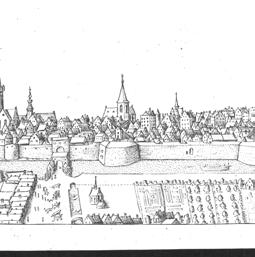
‘I n the first two centuries after the University’s founding in 1636, very few new structures were built of pre-academic hospital for teaching students of medicine to provide hands-on care for the sick. In the church belonging to the former Ursuline convent, now a for the young institution. Lutheran church, an anatomical theatre Most of the space occupied by the Univer- was set up for teaching anatomy lessons. sity came from religious buildings seized from the Roman Catholic Church during That goal of ad pios usus was the source the Reformation. The principle underlying of considerable tension in the 17th century. this reuse was ad pios usus, meaning that Private citizens attempted to gain ownerthe former churches, convents or chapter ship of the religious buildings, too, with houses should be used for new, pious ends, the goal of real estate speculation in mind. such as a hospital or educational institu- The first Professor of Theology, Gisbertus tion. The University’s first building was Voetius, was particularly active in combatthe Groot Kapittelhuis, the large chapter ing those efforts. He recognised this as house of the Dom Cathedral, which is now an opportunity to mobilise the people the Auditorium in the University Hall. against the reigning elite. Voetius, a strict An interior wall was added, dividing the Calvinist, was eager to establish a kind of space to create two lecture halls. theocracy — a civil authority informed and bound by religious laws — in Utrecht. But former church-owned buildings The actual city government was rather elsewhere in the city were adapted for use displeased with this development. in academic education as well. The choir And so the University was drawn into space of the Janskerk church, for instance, the social conflict taking place in the city was turned into a library. Most of the books at that time. in the University’s collection likewise came from convents and abbeys. A Nosocomium was established in the Catharijneconvent on Lange Nieuwstraat. This was a kind At first, the University mostly renovated existing structures. It was not until the 19th century that it began to commission
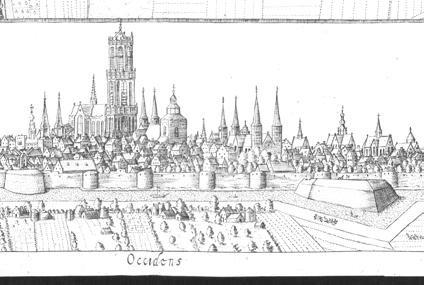
Leen Dorsman was appointed Professor of University History in 2001. He came to Utrecht in 1974 to study at the School of Journalism. After completing that degree, he enrolled as a History student at what was then still called Rijksuniversiteit Utrecht. He took a position as lecturer in the Historiography and Theory department of the Faculty of History in 1984. In 1990, he earned his doctorate for research into the historian Prof. G.W. Kernkamp, who published an extensive history of Utrecht University in 1936. Dorsman has many publications on university history, and the history of UU in particular, to his name. buildings of its own. By that point, it was no longer a city university — one administered by the city government — but a state university, a Rijksuniversiteit. Yet even then, it continued to take up residence in existing buildings. These included the Leeuwenberghgasthuis, where a chemistry lab was set up for Prof. Gerrit Jan Mulder, or the Statenkamer on Janskerkhof, which is now the law faculty but was then where Anatomy was taught. Sonnenborgh was prepared to accommodate the Meteorology and Astronomy scholar, Professor Buys Ballot. And let us not forget the former palace of King Louis I (brother to Napoleon) on Wittevrouwenstraat, to which the library was relocated when the collection outgrew the choir of the Janskerk.
Yet at the same time, the University also began to break ground on its own new construction. This is particularly noteworthy because of the shift toward the edges of the city. The 19th century was an era of professionalisation in the sciences and of growing specialisation. There was a need for new and modern buildings, especially laboratories. The renowned ophthalmologist Prof. F. Donders was given a physiology laboratory located on Van Asch van Wijckkade, while a chemistry laboratory and the City and Academic Hospital (the predecessor of today’s UMCU) were established on Catharijnesingel. A new physics lab arose on Bijlhouwerstraat; today, this building houses the Utrecht School of Governance.
This shift away from the city centre continued in the 20th century, for instance with Dentistry on Jutfaseweg or the Rudolf Magnus Institute on Vondellaan, the latter of which was renovated after the First World War using money from the Rockefeller Foundation. And then of
course, there was still Veterinary Medicine on Biltstraat: an entire complex of fine structures such as the Anatomy building and the Paardenkathedraal (Equine Cathedral). The final step in the migration to the edges of the city was, of course, De Uithof — now known as Utrecht Science Park.
That same outward shift can be seen in the homes of professors over the years. At first, they lived throughout the city centre.


But in the late 19th century, and the first half of the 20th century, professors began to prefer the neighbourhoods in Utrecht-Oost, near the Wilhelminapark and Rijnsweerd.
And quite a few professors did indeed move out of the city following the Second World War, with most of them settling in Bilthoven. The same trend applied to student housing: from buildings in the city centre to the IBB flats or those on Van Lieflandlaan, and from there even further out of the city, all the way to the Science Park.
The University and city have been closely intertwined in other ways as well. Take healthcare, for instance. We already mentioned the Nosocomium. The patients in this hospital, along with those in the later City and Academic Hospital, were residents of the city. The same was true of the patients in Donders’ eye hospital, the Ooglijdersgasthuis. In addition to such direct medical care, the University was also active in countless health committees during the 19th century, such as the one in connection with the city’s drinking water supply. Until the 19th century, people generally got their water directly from the canals. It is therefore unsurprising that Utrecht was struck by several cholera epidemics in succession, which between them claimed thousands of lives. Various professors joined in efforts to this deadly threat under control.
In short: the University was a highly visible presence in the city. This visibility was quite literal, as it was possible to distinguish students from the rest of the citizenry by their clothing, while
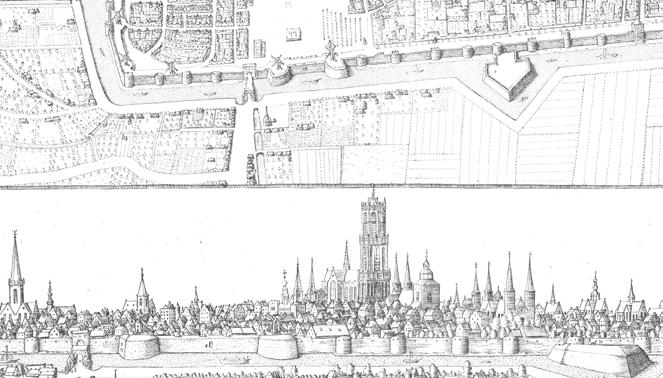
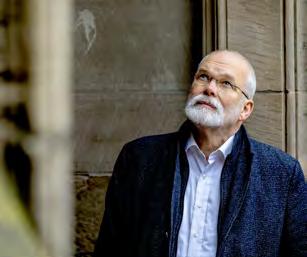
professors also regularly appeared in public in their academic gowns. There was a tradition that after their inaugural lecture, newly appointed professors would be escorted home in full academic regalia by a procession of students. On occasion, the students also made their presence known through bad behaviour. A common prank was to startle citizens on the street by unexpectedly clanging a sword against the paving stones. Less harmless antics included throwing rocks through the windows of the bourgeoisie and getting into fistfights with one another. In the University’s earliest years, a predecessor of today’s social societies existed in the form of the nationes, which were made up of students from the same region. These nationes — from Gelderland or Overijssel, for instance — were rather inclined to physical altercations: so much so, in fact, that they were eventually outlawed.
The University was especially and extravagantly visible in the city when celebrating its anniversaries. At first, only a 50th or 100th anniversary was reason for festivities, but in the course of the 19th century, it became customary to celebrate each five-year anniversary (referred to as a lustrum in Dutch) with allegorical processions depicting themes from antiquity or mythology. These processions later evolved into large-scale masquerade balls orchestrated by the students.
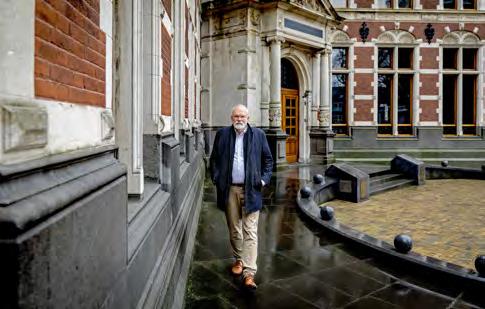
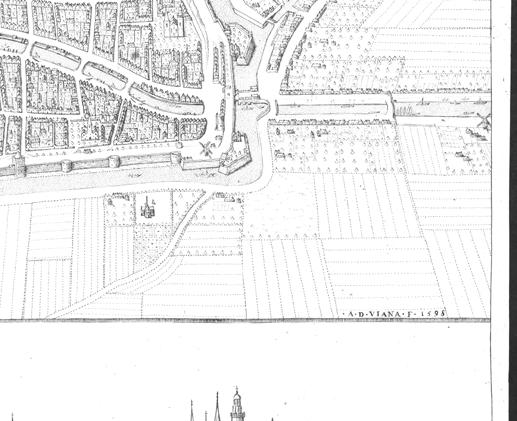
In addition to a procession, ‘There is no longer such a celebration usually included a fireworks display, any need to build too, along with entertainment in the form of recitations and for education songs. and research, but At the second centennial in 1836 — and entirely in keeping rather a need to with the19th century nationalistic tradition — Prince concentrate what Maurice of Orange’s ride to Oostende was recreated. Over already exists’ 700 people took part, more than the total population of the University. And so the garrison was called on to participate as well — and to provide the hundreds of horses involved. The procession set out from Achter de Dom at half past ten in the evening, illuminated by torches, and returned to this starting location at six a.m. the following morning — after a leisurely meal at the Vredenburg which began at four a.m. It was, in other words, an unprecedented theatrical performance, perfect in its historical accuracy. The entire population of the city would come out to watch spectacles of this nature. Leporellos — accordion-folded booklets — were sold to cover the costs.
The University’s involvement in city politics, on the other hand, was quite minimal. Until the late 18th century, in fact, students paid no or very little attention to politics. This did not truly catch on until the Patriottentijd (Patriot Era) in the Dutch Republic of the 1780s, with the most provocative exponent in Utrecht being the student Quint Ondaatje. Another high-water mark in nationalist sentiment occurred in the 1830s, during the Belgian Revolution, when students established a company of volunteer infantrymen — known as Vrijwillige Jagers — to support King William I. Where economics were concerned, however, the University exerted an tremendous influence on life in the city. Students and
professors sometimes hired staff and the University itself employed many people. Landladies, lodging-houses and societies benefited from the presence of the University population, as did local bakers and greengrocers.
Around halfway through the 20th century, that population became less elitist. The University began to grow exponentially, which around 1950 led to a buildings decree calling for a partial relocation to what was then still known as the Johannapolder. As it developed this area became known as De Uithof, now Utrecht Science Park. The big move began in the 1960s. Increased enrolment, but also the fact that many of the labs no longer met current standards, created a need for new construction at a major scale.
At that point, there was some discussion as to whether the entire University should be relocated to De Uithof. This, of course, did not happen: Humanities and Law, Economics and Governance remained in the city centre. Municipal officials were afraid the city centre would die out if the University abandoned it entirely. The buildings alone were a potential problem: what would become of all that space? Conversion to offices seemed to be the only possibility for the buildings. And the city worried about traffic problems as well: bus lines 11 and 12 were already having trouble accommodating the enormous volumes of students.
At first, construction at De Uithof was primarily functional in nature. The Van Unnik building had to be erected in short order to house as many students as possible. The Kruyt building was intended to hold the laboratories and therefore needed to be quite sturdy. Its aesthetic appearance was of little concern. That changed several years later, however, when the idea emerged that Utrecht University should become a kind of ‘Harvard on the Kromme Rijn’, an image that also placed a high value on prestigious new buildings. To that end, renowned architects such as Rem Koolhaas, Wiel Arets and Willem Jan Neutelings were commissioned to build iconic structures. This was incredibly expensive. Today, the University is no longer pursuing that goal. In fact: there is no longer any need to build for education and research, but rather a need to concentrate what already exists.’

HISTORY
Anniversary celebrations
While the University initially only celebrated its 50th and 100th anniversaries, in the course of the 19th century — under the influence of nationalist sentiment — it became customary to organise festivities every five years (referred to as a lustrum in Dutch), typically centred on a nationalistic theme. In the 20th century, those themes became broader and a variety of subjects which speak to the imagination were chosen: François Villon, Akhenaten or Germanicus, for example. The Board of the University delegated the organisation of those festivities to a student society, the Utrechtsch Studenten Corps (USC).
By the 1950s, however, a large portion of the student body no longer joined the USC, making it untenable to place sole responsibility for organising the anniversary activities with the USC. At that point, the University assumed the organisational duties once more — which also put an end to the big masquerade balls. Those processions and large-scale performances had also become somewhat ill-suited to the spirit of the times, as well as being virtually impossible to afford. They were paid for by private contributions, mostly from USC students. These were boys from elite families, to be sure, but even so the sums were enormous. This did generate a great deal of income for the city: every hotel was fully booked, down to the last room. Still, it brought financial ruin for some, as people bankrupted themselves to pay for the anniversary celebrations.

Masquerade procession in the Schoutenstraat during the 295th anniversary (59th lustrum). Image: The Utrecht Archives
A stroll back in time
All around Utrecht this anniversary year, historical knowledge abounds, accessible to all. Tiles with QR codes will be installed at thirty locations where the University and city come together. When you scan one of these codes, you will see stories, photos and video clips from the past, all having to do with that location. Not all of the history at these locations has left traces we can still see today, like the former site of the livestock veterinary clinic on Biltstraat. Did you know, for instance, that excavation work at the site of the Princess Máxima Centre unearthed signs of human habitation dating from before 10,000 BC?
This project is part of the Utrecht Time Machine (UTM) a linked data platform that Prof. Toine Pieters launched three years ago with the goal of bringing the history of Utrecht to life. Pieters is proud to report that the Utrecht Archives will be taking over the management of the Utrecht Time Machine. ‘This project was never meant to be confined to the University; it is all about the world beyond its walls.’ The UTM platform combines data from various museums, the historical association Vereniging Oud Utrecht, the city, the municipal land registry, the Utrecht Archives and other digital historic source files and databases. Alumni are welcome to contribute historic input as well. In the coming years, Pieters will work with students and the Utrecht Archives to further develop the platform and apps that make use of its data.
Over the course of this year, the tiles with QR codes will be ‘connected’ with one another to create walking routes. More information will be made available on the anniversary website morgenmakenwesamen.nl once the tiles have been installed.
The Sputnik Watcher on the Servaas Bulwark
A remarkable statue stands near the Sonnenborgh Museum and Observatory: The Sputnik Watcher. This bronze sculpture was made by Oswald Wenckebach in 1957, shortly after the Soviet Union shocked and amazed the world by launching the first satellite, Sputnik 1, during the Cold War.
David Baneke, UU History and Philosophy of the Sciences, sheds light on the context of this sculpture. According to him, the true winner of the Cold War was the field of astronomy. Also in Utrecht, where Professor Kees de Jager founded the ‘Working Group on Outer Space Exploration of the Sun and Stars’ in 1961. Within ten years, this working group had a staff of more than one hundred people. De Jager, who even lived at Sonnenborgh until 2003, also played a role in what you might call an early form of crowdsourcing. Both the United States and the Soviet Union made use of amateur astronomers all around the world. Using these amateurs’ observations, it was possible to accurately chart the path of a satellite orbiting the Earth. De Jager shared the data collected by Dutch ‘Sputnik watchers’ with colleagues in both countries.
Would you like to know more? David Baneke also discussed the satellite observations in the radio documentary Het Spoor Terug: de Spoetnikkijker (The Trail Back: the Sputnik Watcher), which alumnus Nienke Zoetbrood (Language and Cultural studies, 2014) created for the OVT programme: bit.ly/ovt-spoetnikkijker (in Dutch).
The Dom Tower is the most iconic structure in Utrecht. Practically every UU student has climbed the 465 steps at one point or another. But there are also alumni who have done so hundreds of times. This is because almost all the Dom Tower guides are UU students. Master’s student Dorine van de Klashorst has been working as a guide for five years: ‘This is the best part-time job in Utrecht. I earn money by telling people about this impressive building and promoting enthusiasm for its history. I don’t plan to quit until I take a full-time job after graduation.’
Jitte Roosendaal is a Social Geography alumnus and, as an employee of Utrecht Marketing, has been ‘head guide’ at the tower for over 25 years. He has seen hundreds of students come and go and trained them all to be Dom Tower guides. ‘Many first-year students have come a long way from home to attend UU. Buildings like the tower appeal to their imagination. It is the pride of the city.’ Recruiting guides has never been a problem: ‘When there’s an opening, the students pass it on. It’s also a really fun group of guides who really look out for each other. In all these years, that has never changed.’

Dorine’s own experience confirmed this: ‘I have a group of “tower friends” I met through this job. We have dinner together regularly. Although not a student society, for a lot of the guides it feels like one. Both the tower and the University have played a big role in my life in the past few years. Both places make me feel comfortable, like I’m at home.’
Visit domtoren.nl to find plenty of other fun do-at-home activities created by the Tower Guides, including the Big Dom Tower Podcast Show.
Why don’t USC members use the passageway under the tower?
The tower is associated with hundreds of fantastic stories, some of which also feature the University. For instance: once upon a time, a USC member walked through the passageway under the tower just as a student from another society was attempting to commit suicide by jumping from the tower, landing on top of the USC member. The jumper survived, while the USC student unfortunately did not. At least, that’s how the story goes. In any case, it was a long-standing tradition among USC members to walk around the tower rather than through it.










